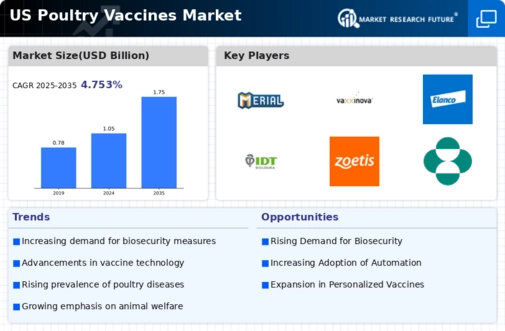Rising Demand for Poultry Products
The increasing consumption of poultry products in the US is a primary driver for the poultry vaccines market. As consumers become more health-conscious, the demand for safe and disease-free poultry has surged. This trend is reflected in the poultry production statistics, which indicate a growth rate of approximately 2.5% annually. Consequently, poultry producers are investing in vaccines to ensure the health of their flocks, thereby enhancing product quality and safety. The poultry vaccines market is likely to benefit from this rising demand, as producers seek to mitigate the risks associated with diseases that can affect poultry health and productivity. Furthermore, the growing awareness of food safety among consumers is pushing producers to adopt vaccination programs, which could lead to an increase in vaccine sales and innovations in vaccine development.
Increased Awareness of Animal Health
The heightened awareness of animal health and welfare among poultry producers is a crucial driver for the poultry vaccines market. Producers are increasingly recognizing the economic benefits of maintaining healthy flocks, which can lead to higher productivity and lower mortality rates. This awareness is reflected in the growing investment in vaccination programs, as producers aim to prevent outbreaks of diseases that can have devastating effects on their operations. The poultry vaccines market is likely to see a surge in demand as producers prioritize health management strategies. Reports indicate that vaccination can reduce disease incidence by up to 30%, underscoring the importance of vaccines in maintaining flock health. As awareness continues to grow, the market is expected to expand, with more producers adopting comprehensive vaccination protocols.
Emerging Diseases and Biosecurity Concerns
The emergence of new diseases and ongoing biosecurity concerns are driving the poultry vaccines market. As pathogens evolve and new threats arise, the need for effective vaccination strategies becomes increasingly critical. Producers are compelled to stay ahead of potential outbreaks by investing in vaccines that can protect against emerging diseases. The poultry vaccines market is responding to this challenge by developing vaccines that target specific pathogens, thereby enhancing biosecurity measures within poultry operations. Reports indicate that outbreaks of diseases such as avian influenza can lead to economic losses exceeding $1 billion, highlighting the urgency for effective vaccination solutions. As biosecurity remains a top priority for poultry producers, the demand for innovative vaccines is expected to rise, further propelling market growth.
Regulatory Support for Vaccination Programs
Regulatory frameworks in the US are increasingly supporting vaccination programs within the poultry industry, which serves as a significant driver for the poultry vaccines market. Government agencies are promoting biosecurity measures and vaccination as essential components of disease prevention strategies. This regulatory support not only encourages producers to adopt vaccination but also provides guidelines for the safe and effective use of vaccines. The poultry vaccines market is likely to benefit from these initiatives, as compliance with regulations can lead to improved flock health and reduced disease outbreaks. Furthermore, financial incentives and subsidies for vaccination programs may emerge, further stimulating market growth. As regulations evolve, the emphasis on vaccination as a critical tool for disease management is expected to strengthen the market.
Technological Advancements in Vaccine Development
Technological innovations in vaccine development are significantly influencing the poultry vaccines market. Advances in biotechnology, such as recombinant DNA technology and mRNA vaccines, are paving the way for more effective and targeted vaccines. These innovations not only enhance the efficacy of vaccines but also reduce the time required for development and production. The poultry vaccines market is witnessing a shift towards more sophisticated vaccine formulations that can provide broader protection against multiple pathogens. For instance, the introduction of vector-based vaccines has shown promise in improving immune responses in poultry. As these technologies continue to evolve, they are expected to drive growth in the market, with an anticipated increase in the adoption of these advanced vaccines by poultry producers across the US.























Leave a Comment